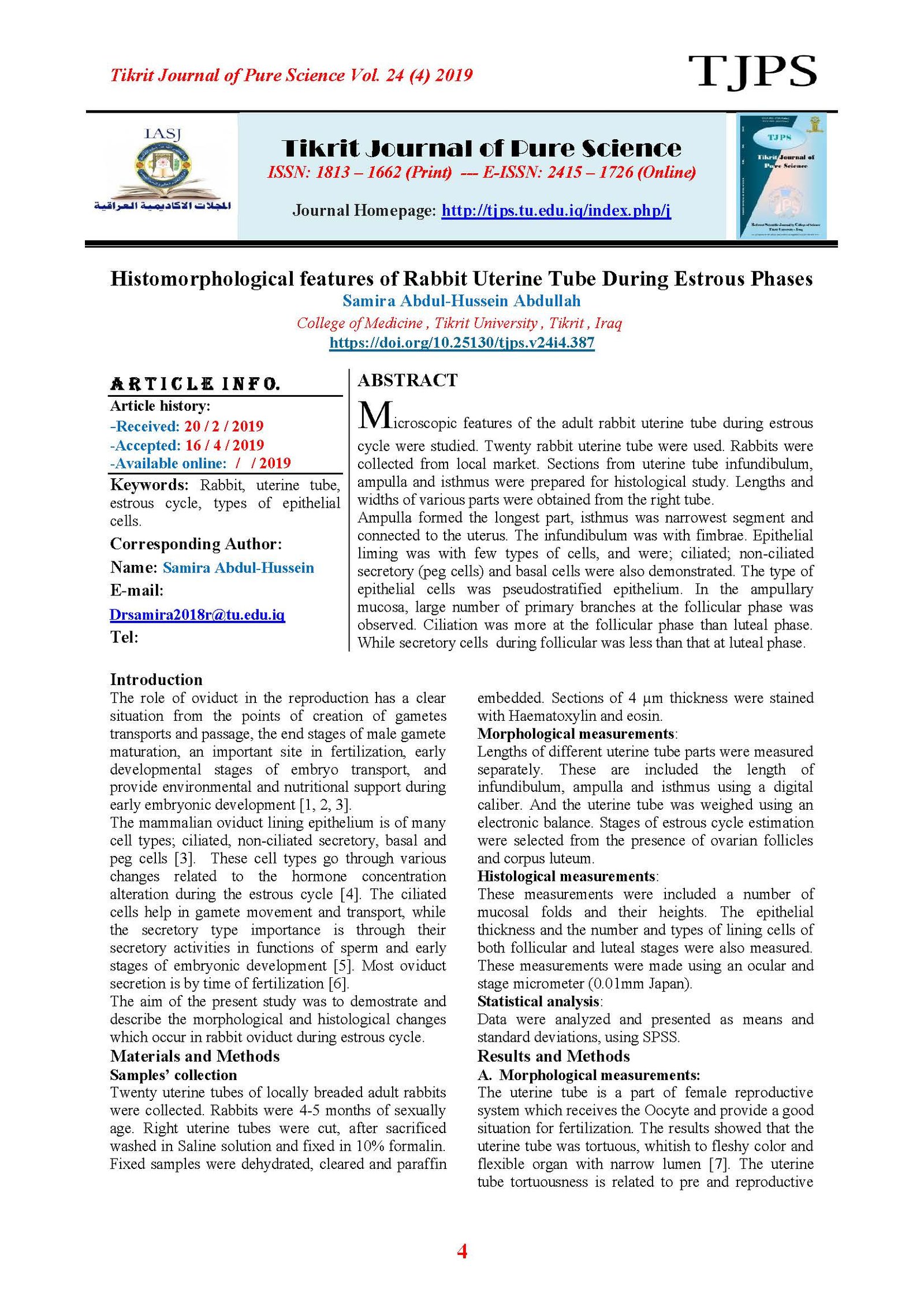Histomorphological features of Rabbit Uterine Tube During Estrous Phases
Main Article Content
Abstract
Microscopic features of the adult rabbit uterine tube during estrous cycle were studied. Twenty rabbit uterine tube were used. Rabbits were collected from local market. Sections from uterine tube infundibulum, ampulla and isthmus were prepared for histological study. Lengths and widths of various parts were obtained from the right tube.
Ampulla formed the longest part, isthmus was narrowest segment and connected to the uterus. The infundibulum was with fimbrae. Epithelial liming was with few types of cells, and were; ciliated; non-ciliated secretory (peg cells) and basal cells were also demonstrated. The type of epithelial cells was pseudostratified epithelium. In the ampullary mucosa, large number of primary branches at the follicular phase was observed. Ciliation was more at the follicular phase than luteal phase. While secretory cells during follicular was less than that at luteal phase
Article Details

This work is licensed under a Creative Commons Attribution 4.0 International License.
Tikrit Journal of Pure Science is licensed under the Creative Commons Attribution 4.0 International License, which allows users to copy, create extracts, abstracts, and new works from the article, alter and revise the article, and make commercial use of the article (including reuse and/or resale of the article by commercial entities), provided the user gives appropriate credit (with a link to the formal publication through the relevant DOI), provides a link to the license, indicates if changes were made, and the licensor is not represented as endorsing the use made of the work. The authors hold the copyright for their published work on the Tikrit J. Pure Sci. website, while Tikrit J. Pure Sci. is responsible for appreciate citation of their work, which is released under CC-BY-4.0, enabling the unrestricted use, distribution, and reproduction of an article in any medium, provided that the original work is properly cited.
References
[1] Hunter, RH.(2012). Temperature gradients in female reproductive tissues. Reproductive Biol. Medicine Online. 24: 377-380.
[2] Miki, K; and Clapham, DE. (2013). Rheotaris guides mammalian sperm. Current Biology.; 23: 433-452.
[3] Mokhtar, MD. (2015.) Microscopic and histological characterization of the bovine uterine tube during the follicular and luteal phases of estrous cycle. J.Microscop. utrastructure.: 44-52.
[4] Yaniz, JL; Lopez-Gatius, F; Santolaria, P; June-Mullins, K. (2000). study of the functional anatomy of bovine oviductal mucosa. Anat. Res.; 260 (3): 268-78.
[5] Steinhauer, N; Boos, A; Gunzel-Apel, AR. (2004). Morphological changes and proliferative activity in the oviductal epithelium during hormonally defined stages of the oestrous cycle in the bitch. Reprod Dom. Anim.; 39: 110-9.
[6] Aguilar, J. and Reyley, M. (2012). The uterine tubal fluid: secretion, composition and biological effects. Anim. Reprod.; 2(2): 91-105.
[7] Flamini, AM; Barbeito, GC and Portiansky, LE. (2014). A morphological, morphometric and histochemical study of the oviduct in pregnant and non-pregnant females of the plains viscacha (Lagostomus maximus). Acta. Zollogica.; 95(2): 186-195.
[8] Devi; Medhi, T; and Hussain, F. (2017). Age related changes of morphology, length and luminal diameter of human fallopian tube. J.Dent. Med. Sci.; 16 (7): 01-08.
[9] Eweka, Ao; Ewek, A; and Ferdinan, AE. (2010). Histological studies of the effects of monosodium glutamate, the fallopian tube of adult female Wistar rats. Europe. PMC plus..
[10] Lyons, RA; Saridogan, E; & Djahanbakhch, O (2006). The reproductive significance of human fallopian tube cilia. Hum. Repro. Update.; 3(1): 8-13.
[11] Crow, J; Amso, N; Lwein, J & Shaw, RW (1994). Morphology and ultrastructure of fallopian tube epithelium at different stages of the menstrual cycle and menopause. Hum. Reprod.; 9: 2224-2233.
[12] Hafez, EE. Reproduction in farm animals. (2000). 4th ed. KM Varghese co. Bombay.: 17-167.
[13] Bridge, DS; Boisvert, C; Bleav, G, and Kan, WK. (2004). detection of nascent and/or mature forms of oviductin in the female reproductive tract and postovulatory Oocytes by use of a polyclonal antibody against recombinant homster oviduction. J. Histochem. Cytochem.: 52(8): 1001-9.
[14] Codan, SM & Gasonova, EB. (2009). Morphology & histological annual changes of the oviduct of chactophractus villosus (Mammalian, xenarthra, Daspodidae). Int. J. Morphol.; 27(2): 355-360.
[15] Ozen, A; Ergun, E; Kurim, A. (2010). histochemistry of the oviduct epithelium in the Angora rabbit. Turk. J. Vet. Anima. Sci.; 34(3): 1-8.
[16] Rajiput, R; and Sharma, DN. (1997). Regional cyclic and gerentological studies on histology and histochemistry of oviduct of Gaddi sheep. Ind. Vet. J.; 74: 580-583.
